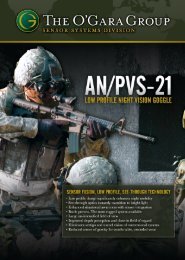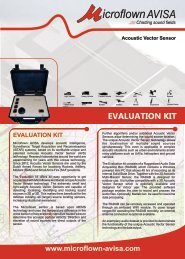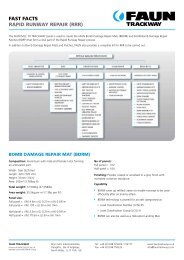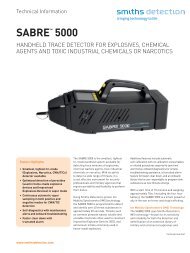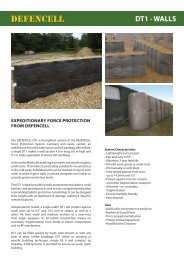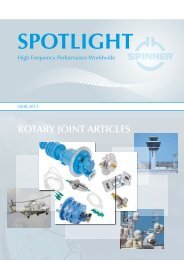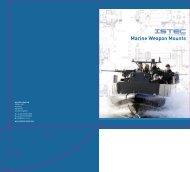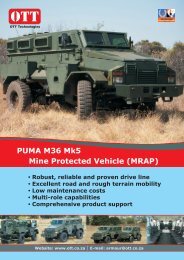Catalog 300 - Kaydon Bearings
Catalog 300 - Kaydon Bearings
Catalog 300 - Kaydon Bearings
You also want an ePaper? Increase the reach of your titles
YUMPU automatically turns print PDFs into web optimized ePapers that Google loves.
REALI-SLIM ® <strong>Bearings</strong> <strong>Catalog</strong> <strong>300</strong> ©KAYDON ® Corporation Issue 10<br />
Section 2–Selection Tables<br />
ULTRA-SLIM ® Thin-Section <strong>Bearings</strong><br />
Ideal for applications in robotics,<br />
inspection equipment, satellites,<br />
cameras… anywhere precise positioning<br />
and lightweight designs are critical.<br />
At just 2.5 mm wide, ULTRA-SLIM ® bearings are available<br />
in bore sizes ranging from 35 mm to 170 mm for an array<br />
of applications. Their compact profile allows you to use<br />
ULTRA-SLIM ® bearings in many highly confined spaces.<br />
Precision-engineered ULTRA-SLIM ® bearings are made of<br />
stainless steel for corrosion resistance. They are available in<br />
angular contact (Type A), radial contact (Type C), and fourpoint<br />
contact (Type X) styles. (See selection charts at right.)<br />
Hybrid bearings with ceramic balls are available upon request.<br />
These configurations are used often when lubrication is<br />
marginal or when lower wear generation and/or lower torque<br />
levels are required.<br />
Figure 2-11<br />
How to identify ULTRA-SLIM ® <strong>Bearings</strong> using our part number code<br />
Position 1 2 3 4 5 6 7 8 9 10<br />
Nomenclature Material Bore (mm) Width(mm) Type Separator Precision Internal Fit<br />
Example S 1 1 0 0 3 C S 0 K<br />
Explanation of position numbers:<br />
Position 1—Material<br />
S = AISI 440C races and balls<br />
(Standard for Series)<br />
Positions 2, 3 and 4—Bore<br />
Nominal bearing bore in mm.<br />
Positions 5 and 6—Width<br />
Nominal radial race width in mm.<br />
Position 7—Bearing Type<br />
A = Angular Contact<br />
C = Radial Contact<br />
X = Four-Point Contact<br />
Position 8—Separator<br />
S = Spacer balls<br />
F = Full complement of load balls<br />
Position 9—Precision<br />
0 = KAYDON standard precision class<br />
Position 10—Internal Fit<br />
A = 0.000 - 0.013 mm clearance<br />
C = 0.013 - 0.025 mm clearance<br />
E = 0.025 - 0.051 mm clearance<br />
K = 0.000 - 0.013 mm preload<br />
M = 0.013 - 0.025 mm preload<br />
empty = standard internal fitup if not specified<br />
Performance and Application Considerations<br />
ULTRA-SLIM ® bearings are unique in that their<br />
extremely thin cross section enables them to provide<br />
great size and weight reductions for light to medium<br />
duty applications with slow or intermittent rotation.<br />
Given the fact that these bearings will most likely<br />
be used in lightly loaded applications where saving<br />
weight and space are the main objective, the loading<br />
values shown assume that the shaft and housing<br />
will also be of light construction. This will allow for<br />
greater bearing ring movement under load than<br />
traditional heavy section bearings. Thus the loading<br />
limits for capacity are not based on ABMA standards.<br />
Depending on the support provided by the shaft and<br />
housing, this movement can create increased stress<br />
levels within the bearing. Distortion of the shaft<br />
and housing under load will transfer to the bearing,<br />
causing increased stress levels which could lead to<br />
premature failure and/or erratic torque conditions.<br />
The impact of non-uniform shaft and housing<br />
distortions is best found by testing. If problems are<br />
experienced, increased rigidity of the shaft and housing<br />
may be necessary. If the shaft and housing are of<br />
sufficient rigidity, it may be possible for the bearings to<br />
support greater loads than the loading limits provided.<br />
60 | www.kaydonbearings.com 1-800-514-3066





